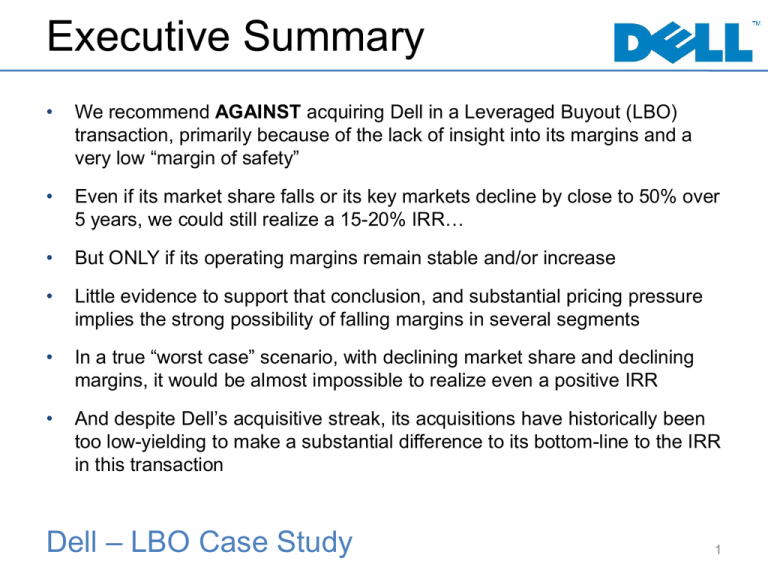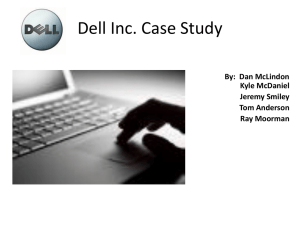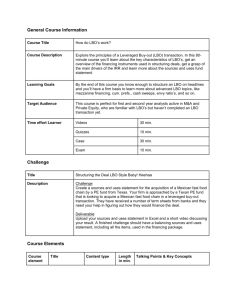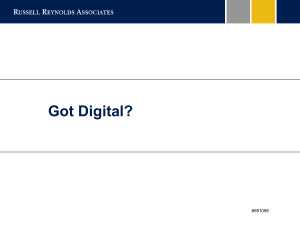Dell LBO Case Study Presentation
advertisement

Executive Summary • We recommend AGAINST acquiring Dell in a Leveraged Buyout (LBO) transaction, primarily because of the lack of insight into its margins and a very low “margin of safety” • Even if its market share falls or its key markets decline by close to 50% over 5 years, we could still realize a 15-20% IRR… • But ONLY if its operating margins remain stable and/or increase • Little evidence to support that conclusion, and substantial pricing pressure implies the strong possibility of falling margins in several segments • In a true “worst case” scenario, with declining market share and declining margins, it would be almost impossible to realize even a positive IRR • And despite Dell’s acquisitive streak, its acquisitions have historically been too low-yielding to make a substantial difference to its bottom-line to the IRR in this transaction Dell – LBO Case Study 1 Market Overview • As desktop and laptop shipments have stagnated or increased modestly over the past 4 years, Dell’s market share has fallen across most of its customer segments: • As a result, our “Base Case” Scenario assumes relatively flat total market sizes and 1-2% drops in Dell’s share over 5 years • Channel checks also indicate substantial pricing pressure in both these markets Dell – LBO Case Study 2 Market Overview (Cont’d) • On the other hand, Dell has grown its market share at a good clip in its Servers & Networking segment, and its Services business has grown substantially: • Channel checks indicate that Dell’s strength in both markets will continue, with some even expecting Servers & Networking market share to increase over the next 5 years Dell – LBO Case Study 3 The Competition • The fiercest competition is in the desktop and laptop segments – channel checks indicate that Dell’s products are perceived as commodities and have little competitive advantage • Also substantial competition in services and software (HP, IBM, Oracle, SAP), but it’s easier to differentiate and bundle solutions there to sell products (based on conversations with IT manager customers) • Unclear how well Dell will perform as an end-to-end IT solutions provider vs. IBM and HP – historically, it has sold only through a direct sales force and has limited experience with VARs • It’s also unclear whether cloud-based solutions or virtual solutions run on company-owned hardware will dominate in the future – if cloud-based solutions win, Dell’s strategy would not work out well • Tablets – yes, there’s massive growth potential but Dell is a very late-mover with entrenched competition (Apple, Google, Samsung) Dell – LBO Case Study 4 Growth Opportunities • Unreasonable to expect much growth in the laptop or desktop segments – at best, perhaps 0% to 1-2% growth even in optimistic scenarios • Best growth opportunities for Dell: Increase market share in Servers & Networking segment Increase Services revenue via more bundles and expansion overseas Grow indirect sales channel for Software / IT Solutions Acquisitions – larger deals such as the Quest and Perot ones • Tablets’ growth potential is huge: • But how will Dell differentiate vs. Apple and Google/Samsung? If Microsoft couldn’t do it, could Dell succeed here? Dell – LBO Case Study 5 Other Factors • Michael Dell’s rollover and ownership percentage (going from ~15% to ~75%) raises serious questions about his motivations • He also missed key trends upon retirement in 2004, prevented acquisitions for several years, and upon his return to the company, took Dell into the “end-to-end solutions provider” game at a very late stage • Unclear what Microsoft’s role will be as a result of its $2 billion subordinated note investment in the deal – could be significant boost to Dell’s hardware, or inconsequential • Going private would not make a huge difference for Dell, and might actually hinder its goals: More difficult to access capital and do large acquisitions Yes, no longer accountable to institutional shareholders… but Silver Lake is unlikely to contribute significant equity given its impact on IRR HP and IBM transformed as public companies… why does Dell need to be private to do this? Dell – LBO Case Study 6 Operating Scenarios • “Base Case” Revenue and Margins: • Based on channel check findings, market size and share estimates, and premium / discount to consensus estimates Dell – LBO Case Study 7 Operating Scenarios (Cont’d) • “Conservative Case”: • “Street Consensus Case”: • “Base Case”: Dell – LBO Case Study Most likely to be somewhere in between these two cases. “Upside Case”: 8 Margins Are Tough to Predict • Dell breaks out OpInc by Customer Segment, but NOT by Product Segment (at least, not officially and not in the past year): • …But nothing on GM / OM for Servers/Networking, Laptops, Desktops, etc. • It discloses almost no information on margins by product: Dell – LBO Case Study 9 Conclusions on Margins • Seems to be the case that “Consumer” segment contributes very little to OpInc, which means that declines in Desktops and Laptops may not mean that much… • But over 50% of OpInc currently comes from “End User Computing” (mostly those two segments), so still significant cause to be concerned over pricing pressure and falling market share • Furthermore, LBO analysis is highly sensitive to margins and even a 1% decline in Operating Margin would reduce IRR by close to 10% • As we’ll see in the next few slides, declines in market share and/or market size in Dell’s top 3 segments matter far less than its ability to maintain or increase its margins • But with almost no data or insight into that, it’s very difficult to make a strong recommendation in favor of this deal Dell – LBO Case Study 10 The Numbers Work… • Sources & Uses and IRR in “Base Case” Scenario (with 2 smaller add-on acquisitions of $1.5B and $2.0B): Dell – LBO Case Study 11 Even in the Downside Case: • If Dell’s 3 top markets (Servers & Networking, Desktops, and Laptops) all decline by 10% per year (close to a 50% cumulative decline from Year 1 to Year 5) and its share stays roughly the same in each market: • Still would not be a total disaster – potentially 10-15% IRR, and maybe even more than that • But all of this assumes that its margins increase by 1-2% over these 5 years, despite the declining market sizes and stagnating shares Dell – LBO Case Study 12 Why The Numbers Work: • Primarily because the company generates $3.0-3.5B+ in FCF each year, even under pessimistic assumptions for market size growth and Dell’s own share in each market • And prior to the deal, it traded at an EV / EBITDA multiple of 3.9x (5.1x purchase multiple), meaning that the yield is much higher than it would be for healthier companies • Plus, we are assuming that Dell repatriates close to $10B of overseas cash and puts it to use financing approximately $6B of the purchase price (after taxes owed on this cash) • And then Michael Dell is rolling over all his equity, and the leverage ratio is fairly aggressive at 5.3x TTM EBITDA • Bottom Line: Silver Lake is contributing very little of its own equity ($1.3$1.4B) for FCF of several times that each year – even with no growth and multiple contraction, that’s a winning formula Dell – LBO Case Study 13 What About Margins? • Base Case Scenario, but Gross Margin and Operating Margin stay the same rather than increasing by 2% over 5 years: • And if Gross Margin falls by less than 1% and EBITDA Margin declines by 1.5%: Dell – LBO Case Study 14 True Downside Cases: • Street Consensus Case: • Our Own “Downside” Case: Dell – LBO Case Study 15 But Will Margins Really Fall? • That is the crux of this deal – very difficult to say with the limited information we have • If “End User Computing” really contributes over 50% of Operating Income and the company comes under even more price pressure there, margins could easily fall • More software/services revenue would help, but those segments are not growing quickly enough to offset the decline in OpInc from desktops and laptops • Which means that there isn’t much of a margin of safety for this deal in case everything goes wrong – we’ve used most of the excess cash to fund the initial deal, and even add-on acquisitions will not help much • So this is a case where the deal could potentially work well, but also where the “Downside” cases are too extreme to overlook Dell – LBO Case Study 16 Will Acquisitions Help? • “Base Case” Sensitivities for Acquisition Size and OpInc Yield: • More of a difference in the case where margins stay the same: • Bigger acquisitions generally REDUCE IRR because Silver Lake chips in more equity – would only improve things at higher yields of above 15-20% Dell – LBO Case Study 17 What Would Make It Work? • Point #1: If we were reasonably certain that margins could be maintained or increase, deal would look much better and margin of safety would increase • Point #2: If we had a detailed breakout of OpInc by product segment and found that the decline in desktops and laptops did not make a substantial difference, the deal would also look better: • Point #3: If there were a clear buyer for Dell’s entire business in several years – selling off business lines separately is much more difficult • Point #4: If there were several other viable acquisition targets (that had not already been acquired by IBM or HP) that could be acquired for < 5-6x EBIT and contribute substantially to Dell’s bottom line Dell – LBO Case Study 18 Is Southeastern Right? • They have a point… • Yes, Dell probably is worth more than $13.65 per share since net cash alone accounts for ~$3.50+ of that value • But $24.00 per share seems quite optimistic – perhaps something in the $15.00 - $20.00 range (and the LBO still works in that range) • Biggest question mark is the true value of those acquisitions since 2008 and what segments they contributed to – and can the different business units be sold off separately? Dell – LBO Case Study 19 Conclusions • We recommend AGAINST the deal and acquiring Dell in a Leveraged Buyout (LBO) transaction, due to uncertainty around margins and the inability to make high-yielding add-on acquisitions • Most commentary focused on the decline in the desktop and laptop markets, but those are far less significant than even slight margin changes • Client computing is lower margin, yes, but it still contributes over 1/3 of Dell’s FCF, if not more than that • Despite Dell’s claims of 15% IRR on its acquisitions, its most recent deals have yielded < 5% OpInc – so will future deals really help? • In more optimistic scenarios, IRR numbers look very good – but if there’s a “perfect storm” of declining market sizes and margins, we have very little protection and far too much downside risk • Additional data / insight into margins by segment and trends there might change this conclusion, but this is our current view Dell – LBO Case Study 20











